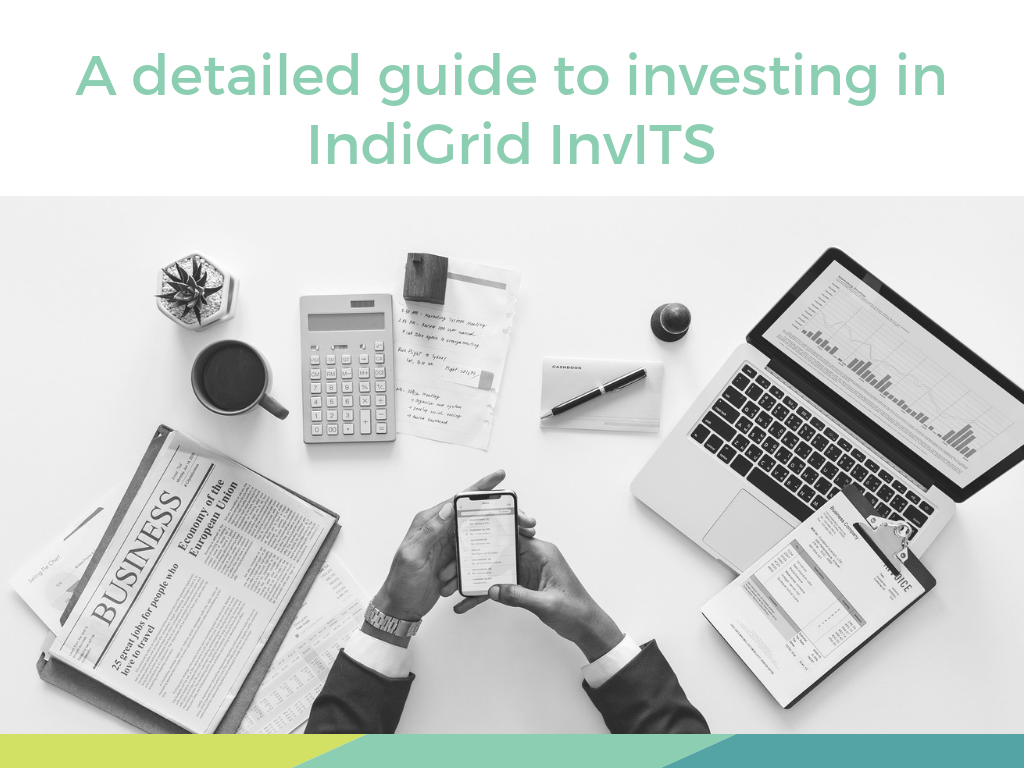What are InvITs?
InvITs or Infrastructure investment trusts are set up with an aim to create a steady flow of cash for investors by helping them to grow their assets. They operate towards releasing capital in existing projects and further help use it to build newer assets. Investing in such projects helps to create new assets along with one’s existing capital.
Assets that are a part of an InvIT are power generation assets, toll/annuity road assets, power transmission assets, and ports. Each of these assets has a risk profile which means that any InvIT is a hybrid product. A hybrid product means that it is a combination of debt and equity. This helps to diversify your risk and ensure steady growth in one portion along with the possibility of good returns from the good performance of underlying assets. Returns are offered to investors is in the form of dividend, interest or capital.
What is India Grid Trust?
IndiGrid is also known as India Grid Trust was established in 2016 by Sterlite Power Grid Ventures Limited as an InvIT (infrastructure investment trust). As a part of this trust, IndiGrid has acquired 10 interstate transmission projects.
Why invest in power transmission?
– Assets and Investments are safe:
Returns from various infrastructure projects like roads, ports and power generation rely mostly on the operational performance of the assets. This is in turn dependent on factors where developers have little control. In the case of Inter State Transmission System(ISTS) transmission projects, the revenue counterparty is a pool of distribution and generation companies. This helps to reduce counter-party risks owing to diversification.
Inter-state transmission assets have low Operation and Maintenance costs, at about 7-8%, in comparison to other infrastructure assets like road projects where O&M costs can be as high as 35-40%.
Transmission lines can be used by Telecom and data service companies to provide services in potential semi-urban and rural regions. This would help in diversifying the revenue profile. In this way, transmission projects are insulated from the risk of poor returns due to the probable lower utilization of assets. In this way, they become a very attractive investment to make.
– IndiGrid, an excellent investment
IndiGrid has a target price and a Buy rating of Rs. 100 (as of Mar 2018). The target price is based on discounting the Distribution per Unit (DPU) of cash flows from the InvIT over the residual life of assets post FY 2018 at a cost of equity of 11%. This is assuming the inclusion of 8 assets into the project through FY 2019-22 via funds raised by a 51:49 mix of equity and debt.
The Internal Rate of Return in the IndiGrid is set to reach 12% by FY 2022 assuming Rs.100/unit as the initial outgo.
– High cash flow visibility
Roads, ports and power generation assets are different from other asset classes which usually have a higher risk to return profile. IndiGrid’s ownership of power transmission assets have long-term fixed tariff contracts and offer higher cash flow visibility with decreased risk.
– Aggressive growth
With a target to grow its AUM from Rs. 55 billion to Rs. 300 billion by FY 2022, IndiGrid takes an aggressive approach. Rs195bn of this growth will come from Right Of First Offer assets and the balance through organic/inorganic routes. Another 8 assets are planned in addition to the existing 6 assets within the project. They will be added in 3 tranches over FY 2019-22.
– IRR returns to assess performance
Typically, investors look at the cash yield of the instrument by benchmarking the distribution per unit (DPU) for a given year and dividing it with the prevailing price per unit to arrive at the yield. However, at IndiGrid the Internal Rate of Return is considered an ideal metric to assess performance. It is believed that the IRR is based on the initial cost per unit and is thus the correct method to compute returns.
– IRR returns should also factor in future asset injections
The nature of underlying assets determines whether they may or may not have a long life. Thus, for an investor buying an InvIT, the IRR return would be a function of residual return cash flows from underlying assets which flows to the InvIT.
Key risks
Like all investments, InvITs too come with their own risks. As an Investor, it is important to know the risk that you might be exposed to.
– Fluctuations in Interest Rates
Being hybrid investments with holdings in debts and equity with a long tenure, the benchmark to their returns is the G-Sec yields. The expectations are of 200-300 base points additional IRR returns over G-Secs. IndiGrid is exposed to interest rate risks as it carries external debt at SPV level as well as InvIT level. It is however seen that the trust will continue to deliver additional 200-300 base points return over the Indian G-Sec yields with the addition of new assets into the IndiGrid InvIT.
– Incremental capital raising
The addition of ROFO assets assumes all incremental equity capital fundraising at Rs. 100/share along with leverage at IndiGrid Trust level between 8.35-8.5% for each tranche of incremental asset infusion. But any deviation in the same cause an unexpected dilution at the trust level leading to a change in the IRR returns of the instrument.
– Investment Manager is expected to deliver returns
The responsibility of delivering the returns, managing the risks and ensuring that asset addition takes place at a decent valuation. If an Investment Manager fails at the risk, then the return falls.
– The risk from asset unavailability
IndiGrid’s assets qualify to earn revenues owing to maintaining availability above a certain threshold. However, if this falls below 95% due to unforeseen circumstances – system breakdown, human error and so on. – the company will under-recover revenues and/or face penalties.
– Force Majeure
While loss from force majeure is usually compensated, there may be times when such compensation might not cover the entire loss/damage suffered by the company. This could impact its business and revenues.
– Delays in Payments
State Electricity Boards tend to have weak finances. Power Grids have a direct conflict of interest with transmission asset owner and the Central Transmission Utility. This could lead to delays in payments.
Future and Conclusion
– India’s Power Transmission Sector
The power transmission sector in India can be segregated into the inter-state network (national grid) and intra-state networks (state grids). The management, regulation, and expansion of Inter-state grids fall in the domain of central government and that of intra-state grids fall in the domain of state and state agencies.
In the past 5-6 years, the government has made many additions to inter-state transmission capacities with an eye to ensure robust additions to power evacuation and transmission infrastructure between new power plants and major demand centers. But Intra-state transmission infrastructure development has been unable to be apace due to State Electricity Boards which have struggled with financial constraints.
However, this trend is beginning to change, as UDAY has helped SEBs to better their financials to some extent. The intra-state transmission capex target has been pegged at Rs 1.6 trillion and is likely to be increased to Rs 2 trillion over the next five years. This could become an impetus for the power transmission sector in India.
– Some insights
The revised Central Electric Authority data puts the power requirements for Financial Year 2022/2027 at 1,619MUs/2,130MUs. This indicates a remarkable CAGR of 6-7% in FY 2017 as it includes the savings made from energy efficiency measures.
The peak demand for FY 2022 is 235GW with the peak availability during the year being expected to be 247.5GW. Assuming a 6-7% annual increase in demand, the per capital demand for electricity would grow to 2000kWh by 2030 from the current 1050kWh. Regular demand monitoring is being done keeping in mind the required increase in generating capacities by FY 2024. This will also lead to a higher requirement of transmission capacities.
Moreover, there are about 40 million families in India that currently do not have access to electricity despite it being available for free under the Saubhagaya scheme. Given the impediments in the movement of coal, the generating capacity is set to increase in Pithead centres rather than in load centres. This will require inter/intrastate transmission way beyond that which has been planned till Financial Year 2024.
Edelweiss and ICICI securities have backed IndiGrid as an investment that will have long-term yields. They believe that the revenue earned from long-term contracts will balance out the overall risks.
The Power Transmission sector is thus set to grow by leaps and bounds in the decade to come.
Please note: All financial investments are subject to market risks. We urge to you read the fine print and discuss the investment with your financial planner before investing. This is a sponsored post. You are advised to use your discretion before investing. If you have any questions, please comment and I will be happy to answer them. 🙂

 We remember the day seven years back when were travelling in a Mumbai local trying hard to come up withe a name for our blog when struck us; Khushboo was always called a Jack of all Trades. The name stuck (with a slight modification, of course) and Minni was born. Six years, over 100 collaboration, lakhs of readers and several awards later; our love for blogging continues to grow. We continue to write on an eclectic range of topics from the funniest autorickshaw signs that we have spotted in Mumbai to how to bathe an elephant. We are true blue Munni of all Trades and we hope to continue on this joyride with our fellow Munnies and Munnas.
We remember the day seven years back when were travelling in a Mumbai local trying hard to come up withe a name for our blog when struck us; Khushboo was always called a Jack of all Trades. The name stuck (with a slight modification, of course) and Minni was born. Six years, over 100 collaboration, lakhs of readers and several awards later; our love for blogging continues to grow. We continue to write on an eclectic range of topics from the funniest autorickshaw signs that we have spotted in Mumbai to how to bathe an elephant. We are true blue Munni of all Trades and we hope to continue on this joyride with our fellow Munnies and Munnas. 